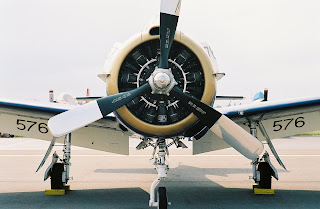 Wright nine-cylinder Cyclone engine, as installed in a North American T-28 Trojan. Photograph taken at AirVenture 2007, the Warbird Flight Line,
Wright nine-cylinder Cyclone engine, as installed in a North American T-28 Trojan. Photograph taken at AirVenture 2007, the Warbird Flight Line, “
“Have you ever had an engine gone wrong?”
The question was asked me by a young boy, 10 years old or so, in the cockpit of an L-1011 while on the ground in
The kids were excited, of course, because they were going back home after a fun vacation. The questions came thick and fast. “What does that do?” “How do you know what all these things do?” “Is it hard to fly an airplane?” But, “Have you ever had an engine gone wrong?” was a new one.
“Gone wrong,” I thought. You mean, like get into drugs? I didn’t say that, of course, but that’s what I was thinking. “That was a good engine until it started hanging around with a bunch of recips.” How could an engine go wrong?
So I did the only sensible thing and said, “Could you ask that question again?” And he said, “Have you ever had an engine gone wrong?”
Right. Probably shouldn’t ask again. So I said, “Do you mean fail? Have I ever had an engine failure?”
“Yes,” he said.
“No.” And at that point I hadn’t. I probably had 7000 or 8000 hours of flying at that point, most of it in multiengine jets, and had never had an engine failure. In fact, I’ve only had one in my entire career, and except for the fact that it occurred on Christmas Eve, ironically departing Orlando (but for Boston, not Manchester), that failure was a simple affair, losing the center engine on a very lightly loaded airplane in good weather at 1000 feet. We shut it down (it was vibrating severely and probably was about to come apart), told the tower we had an engine shut down and needed to come back, circled around and landed. Spoiled Christmas for a very disappointed crew of 12, but it was a big non-event otherwise. Modern turbine engines, unlike their reciprocating ancestors, seldom fail, and when they do it usually is without too much drama.
He said, “Thank you,” and that was that. Then another kid said, “I miss my cat.” With kids, it’s not always about airplanes.
